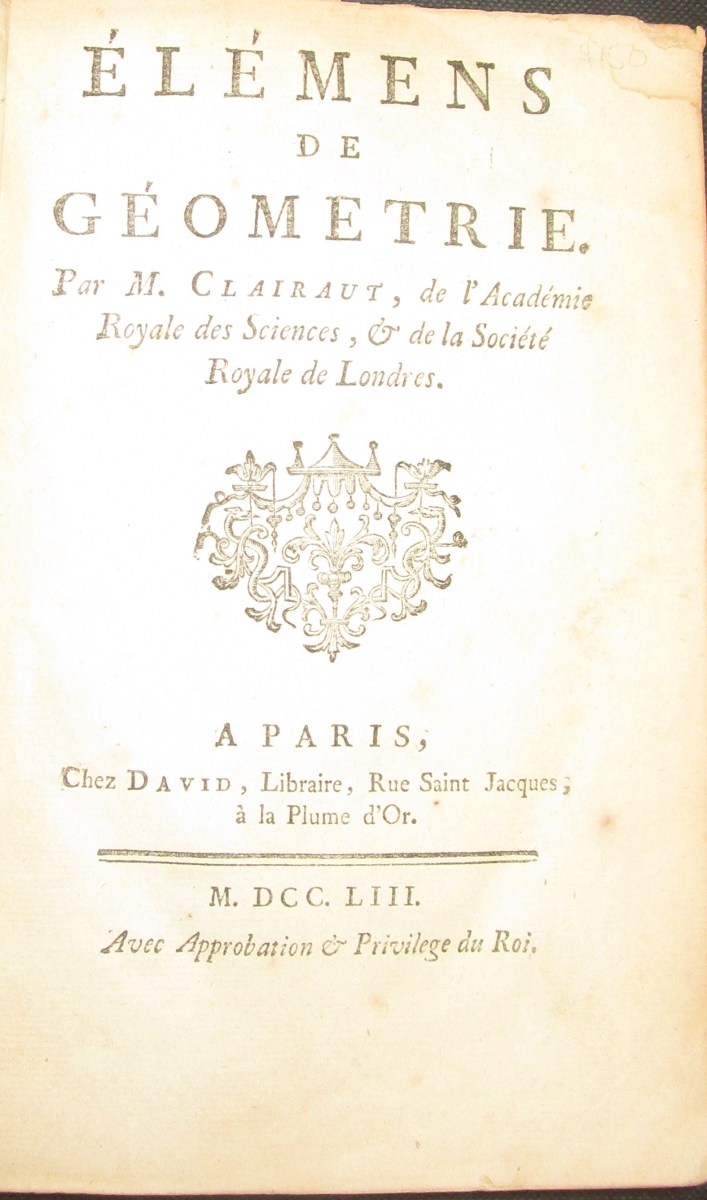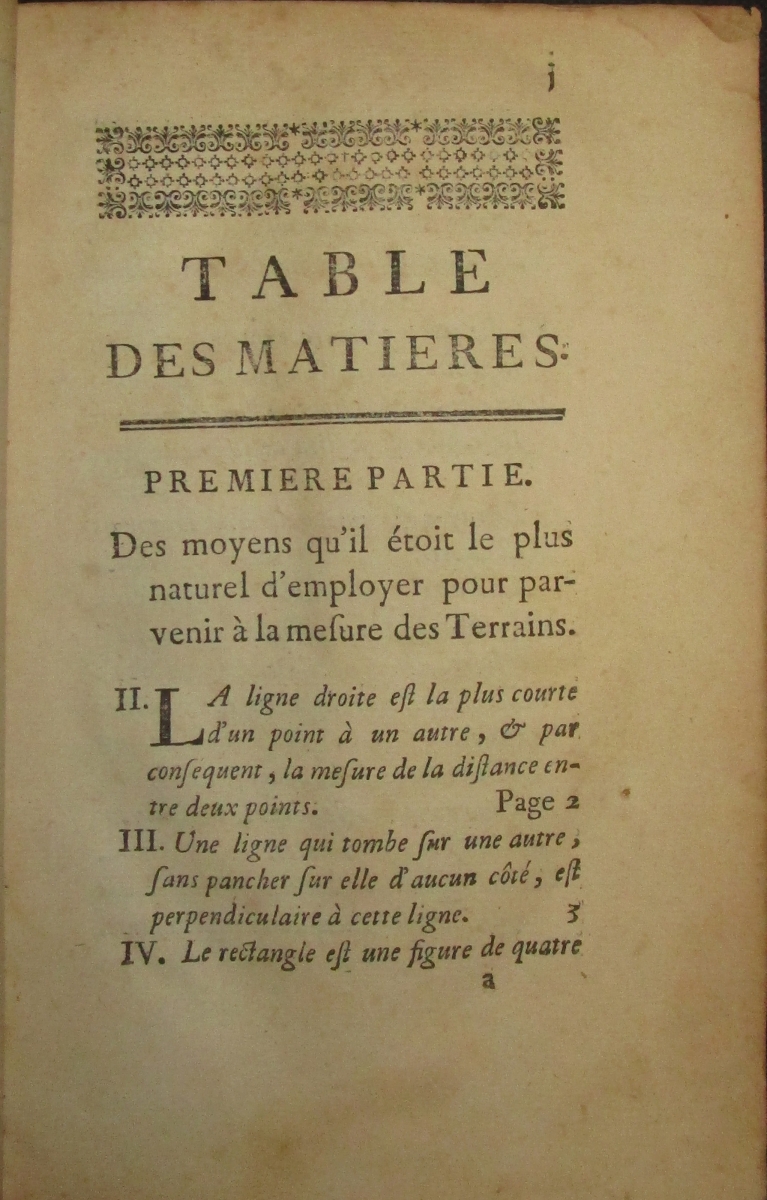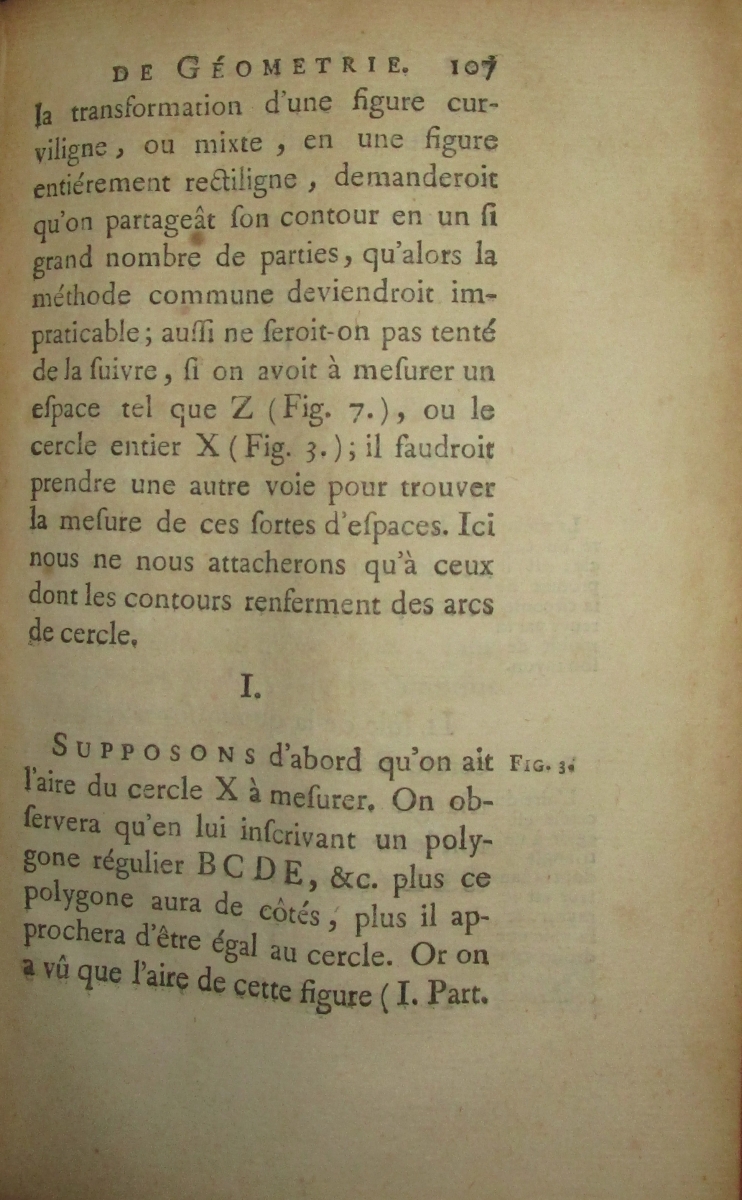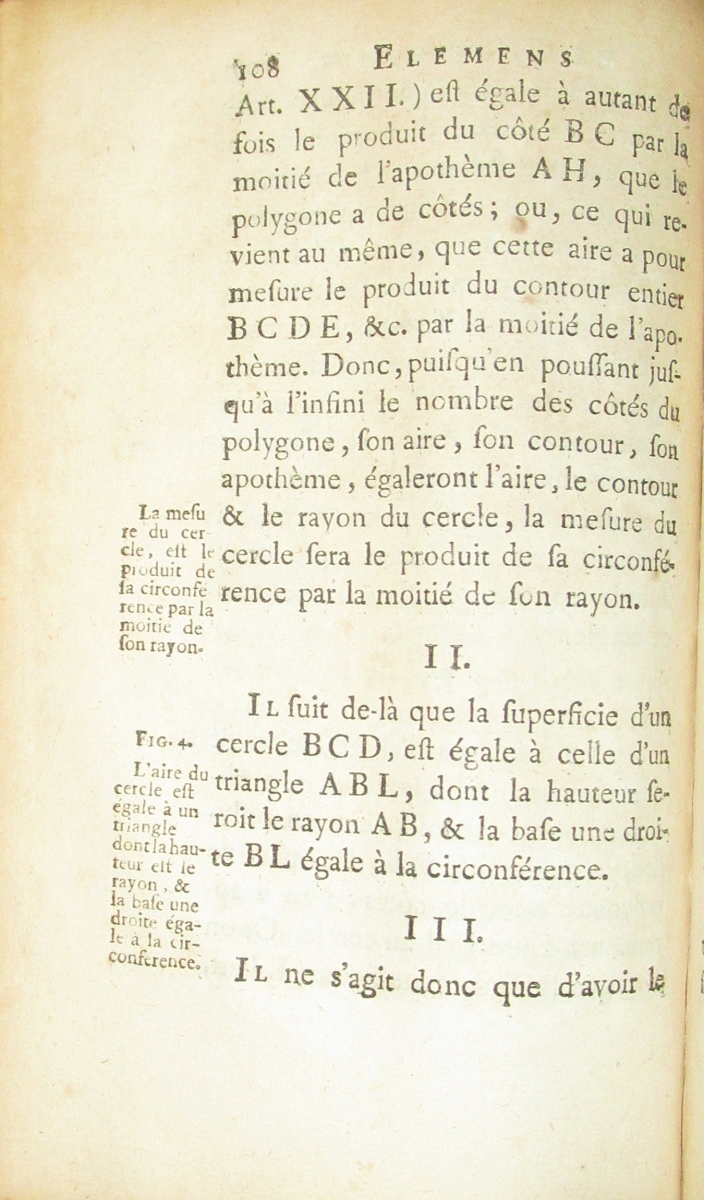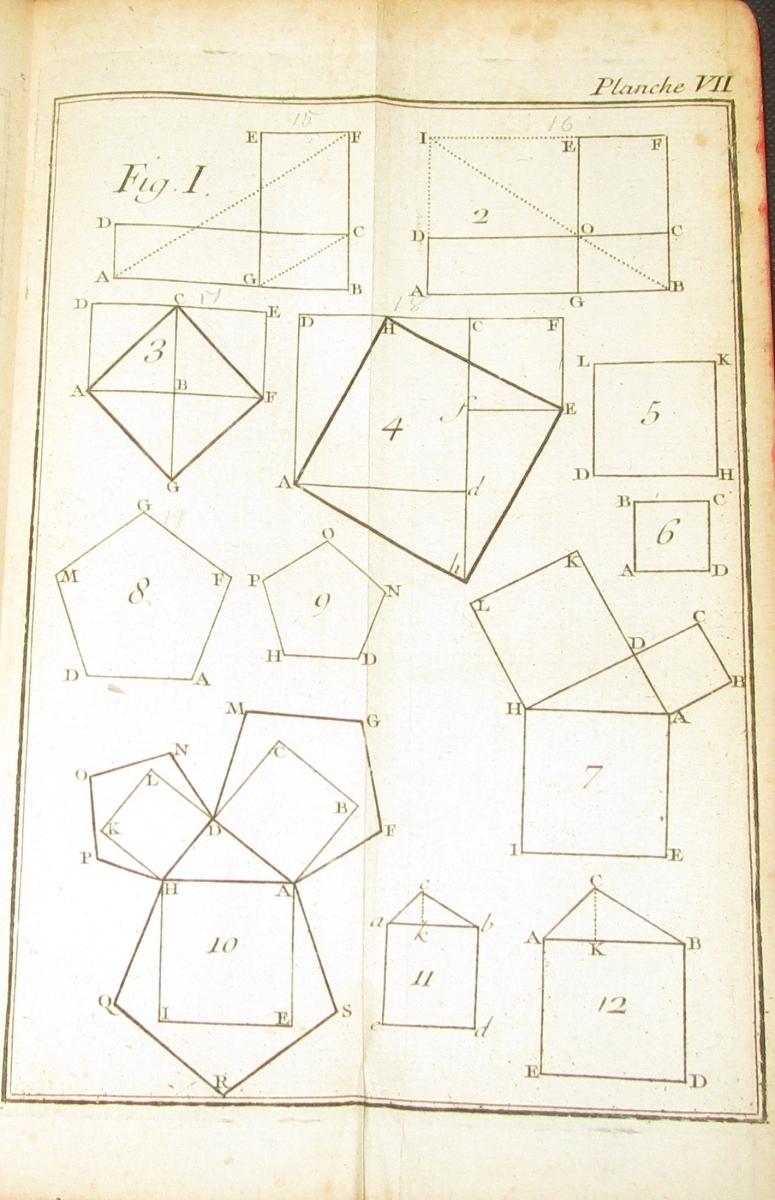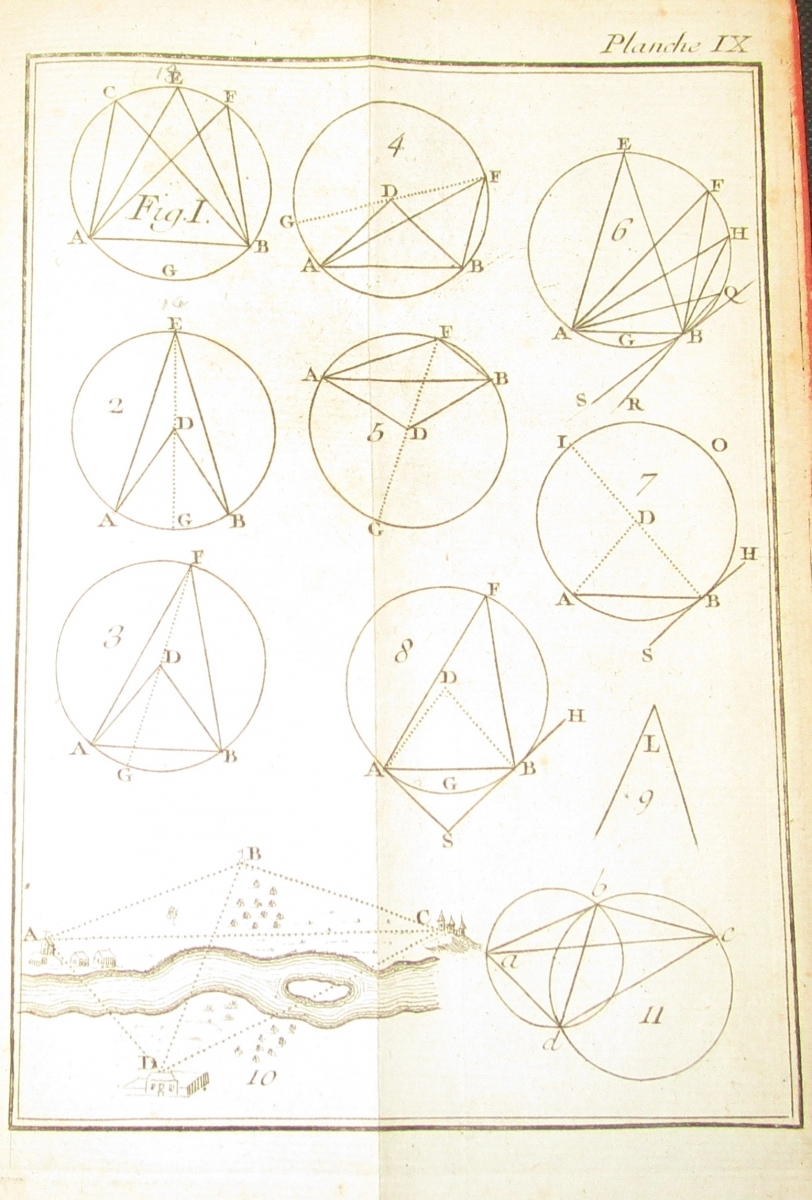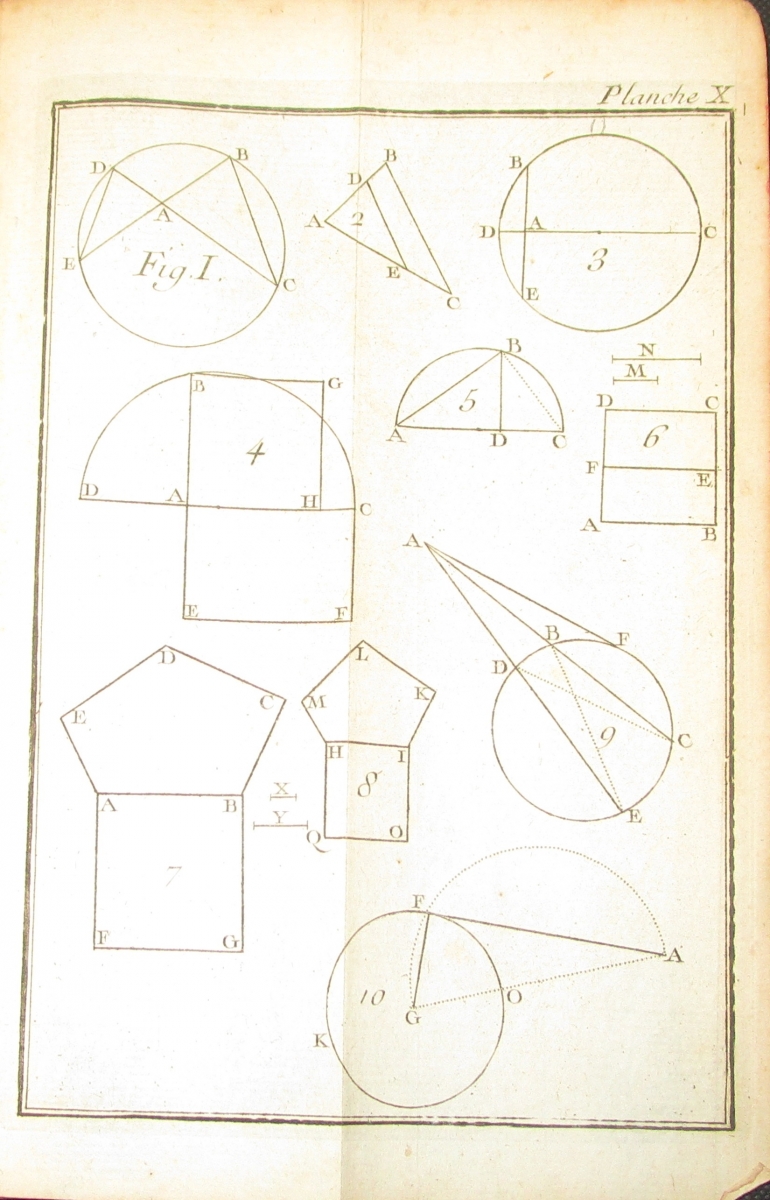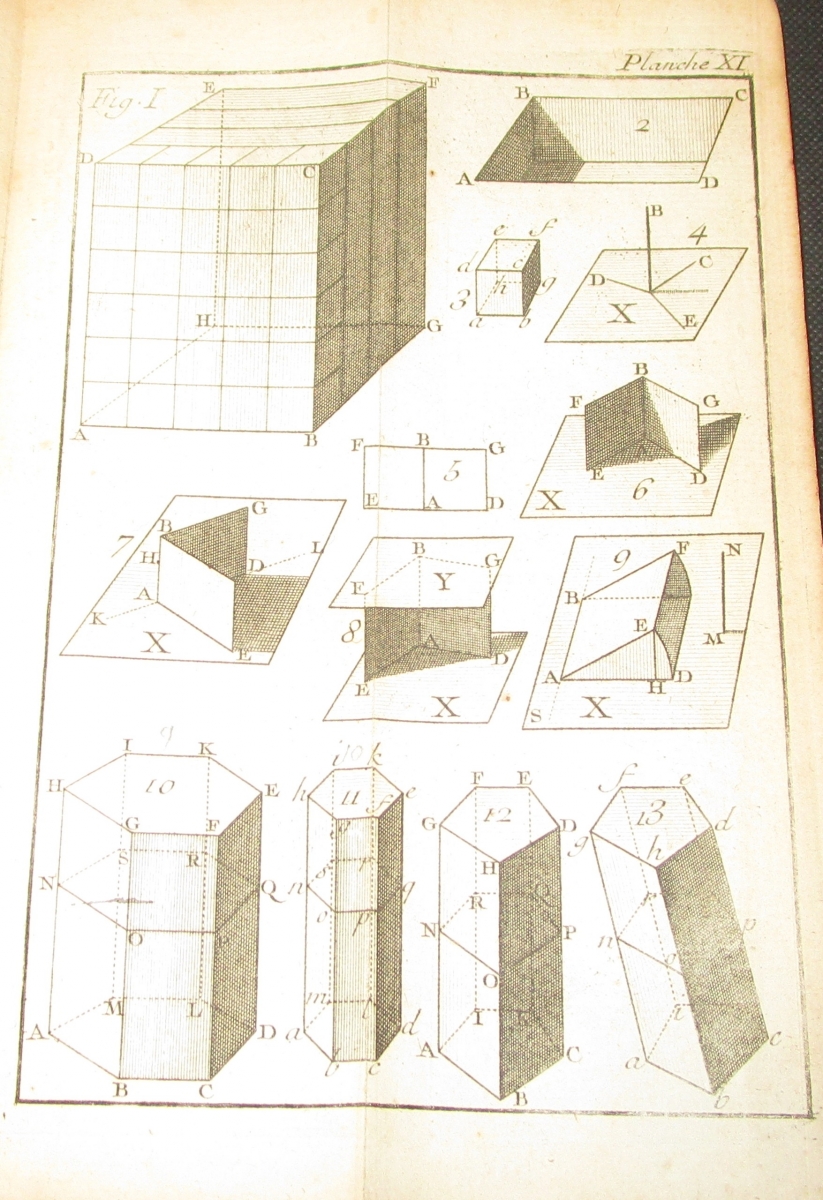- About MAA
- Membership
- MAA Publications
- Periodicals
- Blogs
- MAA Book Series
- MAA Press (an imprint of the AMS)
- MAA Notes
- MAA Reviews
- Mathematical Communication
- Information for Libraries
- Author Resources
- Advertise with MAA
- Meetings
- Competitions
- Programs
- Communities
- MAA Sections
- SIGMAA
- MAA Connect
- Students
- MAA Awards
- Awards Booklets
- Writing Awards
- Teaching Awards
- Service Awards
- Research Awards
- Lecture Awards
- Putnam Competition Individual and Team Winners
- D. E. Shaw Group AMC 8 Awards & Certificates
- Maryam Mirzakhani AMC 10 A Awards & Certificates
- Two Sigma AMC 10 B Awards & Certificates
- Jane Street AMC 12 A Awards & Certificates
- Akamai AMC 12 B Awards & Certificates
- High School Teachers
- News
You are here
Mathematical Treasure: Alexis Clairaut’s Élémens de géométrie
Alexis-Claude Clairaut (1713–1765) was a French mathematician known especially for his work in celestial mechanics and geodesy. His seminal work Théorie de la figure de la terre (Theory of the shape of the Earth), published in 1743, confirmed the belief by Isaac Newton and Christiaan Huygens that the Earth is an oblate spheroid and contributed to the establishment of theoretical mechanics as a discipline in its own right. Shortly thereafter, Clairaut developed a clever approximate solution to the three-body problem, publishing his Théorie de la lune (Theory of the moon) in 1752. This essay, which treated the problem of the movement of the moon’s apogee, won the prize of the St. Petersburg Academy that year. It is perhaps unexpected, then, that Clairaut also became known for his work in mathematics pedagogy. This was achieved through his celebrated Élémens de géométrie (Elements of geometry); a 1753 printing is shown below.
The first edition of this work appeared in 1741. One of a number of 18th-century elementary geometry texts bearing the title “Elements of Geometry,” it was translated into Latin, Italian, German, Dutch, Polish, Portuguese (in Portugal and Brazil), and Swedish by the close of the 1700s, and rendered into English by the mid-19th century. It garnered a particularly large audience in the 1800s, due to reprints in France in 1852 and 1853—at the beginning of the Second French Empire [Barbin and Menghini 2014, p. 481]. Metric measurements were substituted for those of the Ancien régime, and the latter edition was recommended by the Minister of Public Instruction for the teaching of geometry in French high schools [Clairaut 1853]. Similarly, its use in Italian secondary schools was approved by the Superior Council of Public Instruction in 1850 [Clairaut 1850], and a version published “for the use of the Irish National Schools” appeared as early as 1836 [Menghini 2015, p. 571]. By 1906, German historian of mathematics and mathematics teacher Max Simon would place it among the fundamental textbooks of elementary geometry at that time in all “languages of culture,” together with those of Adrien-Marie Legendre, Joseph Bertrand, Étienne Bézout, and Sylvestre François Lacroix [Lorenat 2015, p. 261].
In 1920, Swiss-American historian of mathematics Florian Cajori referred to this text as “an eighteenth century [sic] rival of Euclid’s Elements’’ [Cajori 1922]. Clairaut himself took care to distinguish his work from Euclid’s, with which he had become acquainted in his youth. A precocious child educated entirely at home, his mathematics-teacher father (Jean-Baptiste Clairaut) is said to have taught young Alexis the alphabet using figures and captions from an edition of Euclid’s Elements [Brunet 1951, pp. 13--14]. He read his first paper to the Académie des Sciences there at age 13; it treated four new families of algebraic curves, results inspired, in part, by the problem of finding mean proportionals between two given magnitudes (to which the classical Greek problem of “doubling the cube” could be reduced). He published these results in 1734; additional information on Clairaut’s four curves is available in Convergence.
Clairaut acknowledged, in the preface of his own Élémens, that geometry is an abstract subject. That said, he argued that “the difficulties experienced by those who begin to apply themselves to it most often come from the manner in which it is taught in the ordinary Elements” [Clairaut 1753, p. i]; beginning with definitions, axioms, and preliminary principles is dry and uninteresting to the reader, who is likely to become tired and discouraged before developing any clear understanding of what they are supposed to be learning. In contrast, Clairaut relied on self-evidence, observation and measurement. His aim was to engage readers in solving particular problems and, through them, to gradually discover abstract propositions in a natural way. To do so, he sought to return to the practical matters that may have inspired the first geometers, who he presumed were then led to more theoretical questions by their own curiosity.
Exercises treating these practical matters frequently referred to surveying, with the first chapter treating the measurement of fields—what Clairaut believed to have been the origins of geometry. Nonetheless, Élémens was not a practical text. Clairaut treated most of the main results of books I–IV, VI, XI, and XII of Euclid’s Elements [Katz 2009, p. 688], using measurement as a pedagogical means rather than an end.
Unlike Euclid’s Elements, Clairaut’s Élémens was divided into four parts, each of which was divided into numbered sections. These sections included mathematical content such as propositions that are easily recognizable by modern readers in the table of contents and also as notes in the margins of the appropriate section. The first page of the 1753 table of contents is shown below.
As seen in the image above, the first two mathematical concepts of part one, on land measurement, read (in English translation):
II. A straight line is the shortest from one point to another, & therefore the measure of the distance between two points.
III. A line which falls on another, without leaning toward either side, is perpendicular to this line.
To explain the latter mathematical idea, Clairaut remarked:
A man, for example, placed on the edge of a river, proposes to know how far it is from the place where he is to the other edge AB. It is clear that, in this case, to measure the distance sought, it is necessary to take the shortest of all the straight lines DA, DB, &c. which can be drawn from point D to the line AB. Now it is easy to see that this shortest line which we need is the line DC which we suppose does not cross either towards A, nor towards B [Clairaut 1753, pp. 2–3, translated by the authors] .
These references to land measurement and surveying, while striking in contrast to the treatment found in Euclid’s Elements, appear quite natural in light of Clairaut’s own trajectory and interests. Clairaut was elected to the French Académie des Sciences at age 18, though he had been proposed for membership two years prior. In that milieu, he became acquainted with eminent figures, the likes of whom included Pierre-Louis Maupertuis (1698–1759). Clairaut and Maupertuis were among the early French supporters of Newton’s natural philosophy, and in 1736, a small group including Clairaut, Maupertuis, and Anders Celsius (1701–1744; known for inventing his namesake temperature scale) embarked on an expedition to Lapland, organized by the French Académie, with the aim of measuring the length of a degree of the meridian in a region as near to the North Pole as possible (a second similar edition was sent to Peru to measure the length of a degree near the equator; the aim was to compare the two). Their findings supported the Newtonian model for the Earth’s oblate shape and resulted in Clairaut’s 1743 work, noted above, which demonstrated how to compute flattening of the Earth using gravity measurements via Clairaut’s theorem.
Part two of Clairaut’s Élémens is devoted to the geometrical method of comparing rectilinear figures. In it, he leads the reader to their exact ratios using a ruler and compass, and he demonstrates, among other things, the geometric result corresponding to the so-called Pythagorean theorem.
The third part, devoted to the measurement of circular figures and their properties, uses exact methods rather than approximations. The fourth and final part treats solid figures, generalizing findings from earlier in the text. For additional discussion summarizing the contents and structure of Clairaut’s Élémens, see [Gosztonyi 2022].
As for how to employ the concept of measurement in learning geometry, in his Élémens, Clairaut measured rectangles using squares of unit side length, with one’s area corresponding to the product of the measurements of its length and width. A triangle, half a rectangle, could be measured accordingly. Fields, however, did not always have straight sides. To measure such regions, Clairaut indicated that curved sides could be approximated using segments of straight lines; the region could then be divided into triangles. Geometers, however, generally preferred a more rigorous approach of measuring regions directly. In this vein, Clairaut derived the precise area of a circle (equal to the product of its circumference and half of its radius). Rather than employ the method of exhaustion and Reductio ad absurdum, he showed that the area of a regular polygon is given by the product of its perimeter and half its apothem. Then, he treated a circle as a polygon with infinitely many sides, with the perimeter and apothem of the polygon corresponding, respectively, to the circumference and radius [Katz 2009, pp. 688–689]. This argument is depicted in the images below, with Clairaut’s statement of the area of a circle found in the first note in the margin on page 108.
In contrast, Euclid proved that the areas of two circles are to one another as the areas of the squares on their diameters; no area formula, itself, is given.
All figures cited in Clairaut’s text are found in plates located at the end of the work. Below are several examples:
Note that figures 7 and 10 of Plate VII correspond to the so-called Pythagorean theorem and its generalization. Plates IX and X correspond to the third part of the volume. Note especially figure 10 of Plate IX, which corresponds to finding the distance from one place to three others whose positions are known.
Plate XI corresponds to the fourth and final part of the volume.
All images are photographs taken by Bruce Burdick of his 1753 Chez David printing of Clairaut’s Élémens de géometrie. Interested readers can find this edition online, in full, through the European e-rara archive. Images from an Italian translation may be viewed in Convergence’s Mathematical Treasures.
References
Barbin, Evelyn, and Marta Menghini. 2014. History of Teaching Geometry. In Handbook on the History of Mathematics Education, edited by A. Karp and G. Schubring, 473–492. New York: Springer.
Brunet, Pierre. 1951. La vie et l'oeuvre de Clairaut. Revue d’histoire des sciences 4(1): 13–40.
Cajori, Florian. 1922. Review of Éléments de Géométrie, I et II, by Alexis-Claude Clairaut. Bulletin of the AMS 28(3): 133.
Clairaut, Alexis-Claude. 1753. Elémens de géométrie. Paris: David.
Clairaut, Alexis-Claude. 1850. Elementi di geometria di Clairaut. Nuova Traduzione Italiana con note, Approvata dal Consiglio Superiore di Pubblica Istruzione per uso delle scuole secondarie e speciali. Torino: Stamperia reale.
Clairaut, Alexis-Claude. 1853. Eléments de géométrie, par Clairaut, ancien membre de l'Académie des sciences. Nouvelle édition mise en accord avec le système décimal, par M. Honoré Regodt, professeur à l'association philotechnique de Paris. Paris: Jules Delalain.
Gosztonyi, Katalin. 2022. Series of problems in Clairaut’s Elements of Geometry: interaction between historical analysis and mathematics education research. ZDM – Mathematics Education 54: 1463-1478.
Katz, Victor. 2009. A History of Mathematics: An Introduction. 3rd ed. Boston: Addison-Wesley.
Lorenat, Jemma. 2015. ”Die Freude an der Gestalt” : methods, figures and practices in early nineteenth-century geometry. PhD dissertation, Université Pierre et Marie Curie - Paris VI and Simon Fraser University.
Menghini, Marta. 2015. From Practical Geometry to the Laboratory Method: The Search for an Alternative to Euclid in the History of Teaching Geometry. In Selected Regular Lectures from the 12th International Congress on Mathematical Education, edited by S.J. Cho, 561–588. New York: Springer.
Laura Turner (Monmouth University), with images provided by Bruce Burdick (Roger Williams University), "Mathematical Treasure: Alexis Clairaut’s Élémens de géométrie," Convergence (July 2023)

